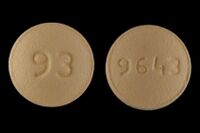Prochlorperazine
| Prochlorperazine | |||||||||||||||||||||||
|---|---|---|---|---|---|---|---|---|---|---|---|---|---|---|---|---|---|---|---|---|---|---|---|
 |
|||||||||||||||||||||||
| Chemical Nomenclature | |||||||||||||||||||||||
| Common names | Compazine, Stemzine, Buccastem, Stemetil, Phenotil | ||||||||||||||||||||||
| Systematic name | 2-chloro-10-[3-(4-methyl-1-piperazinyl)propyl]- 10H-phenothiazine | ||||||||||||||||||||||
| Class Membership | |||||||||||||||||||||||
| Psychoactive class | Antipsychotic | ||||||||||||||||||||||
| Chemical class | Phenothiazine | ||||||||||||||||||||||
| Routes of Administration | |||||||||||||||||||||||
|
|||||||||||||||||||||||
| Interactions | |||||||||||||||||||||||
 |
This article is a stub. As such, it may contain incomplete or wrong information. You can help by expanding it. |
Prochlorperazine (Compazine, Stemzine, Buccastem, Stemetil, Phenotil) is a dopamine (D2) receptor antagonist that belongs to the phenothiazine class of antipsychotic agents that are used for the treatment of nausea and vertigo. It is also a highly potent typical antipsychotic, 10–20× more potent than chlorpromazine. It is also used to treat migraine headaches.[1]
Chemistry
Pharmacology

Prochlorperazine is thought to exert its antipsychotic effects by blocking dopamine receptors.[2]
Prochlorperazine is analogous to chlorpromazine, both of these agents antagonize dopaminergic D2 receptors in various pathways of the central nervous system. This D2 blockade results in antipsychotic, antiemetic and other effects.
Subjective effects
The effects listed below are based upon the subjective effects index and personal experiences of PsychonautWiki contributors. The listed effects will rarely if ever occur all at once but heavier dosages will increase the chances and are more likely to induce a full range of effects.
Physical effects
The physical effects of prochlorperazine can be broken down into 5 components all of which progressively intensify proportional to dosage. These are described below and generally include:
Cognitive effects
The general head space of prochlorperazine is often described as one of sleepiness, emptiness, apathy, stupor and catatonia. The specific cognitive effects can be broken down into 6 components all of which progressively intensify proportional to dosage. These are described below and generally include:
- Thought deceleration
- Emotion suppression
- Information processing suppression
- Language suppression
- Amnesia
- Anxiety suppression
Toxicity and Harm Potential
Lethal dosage
Tolerance and addition potential
Legal Issues
- UK: Available over the counter and as prescription medication.
- USA: Available only through prescription.
- Australia: Available only through prescription.